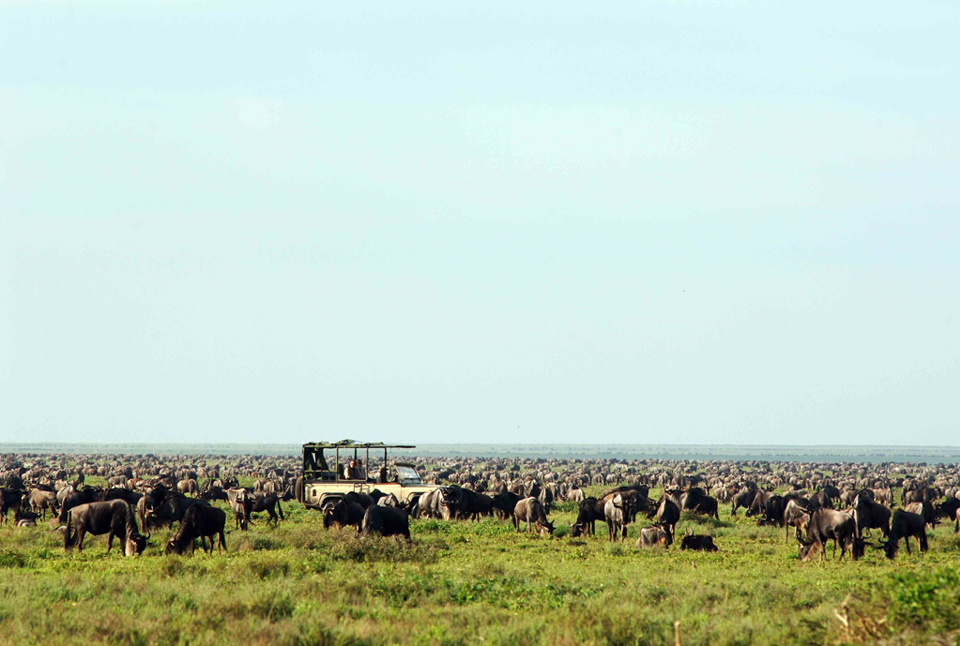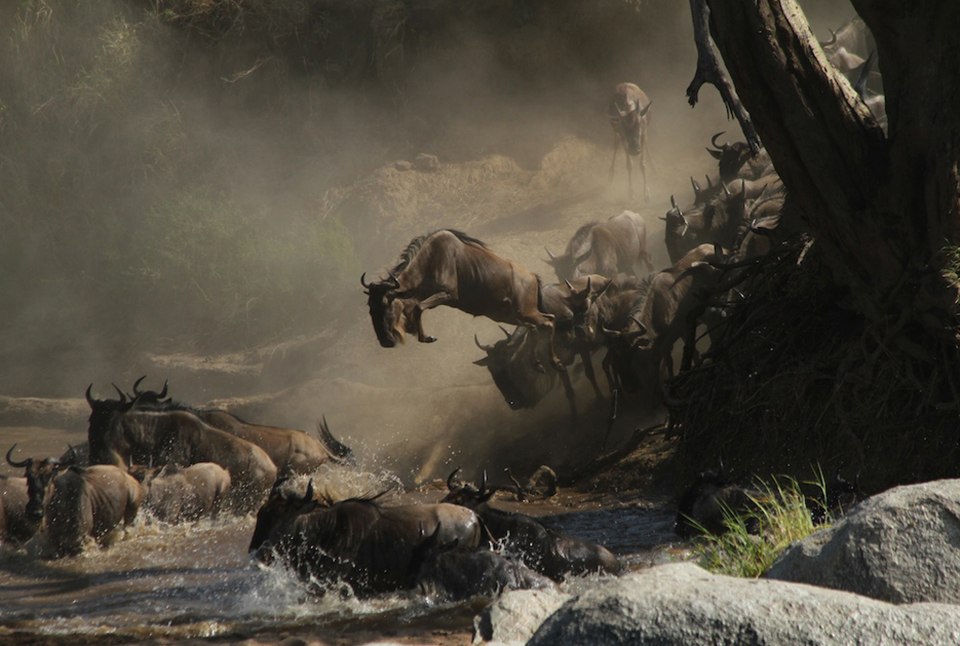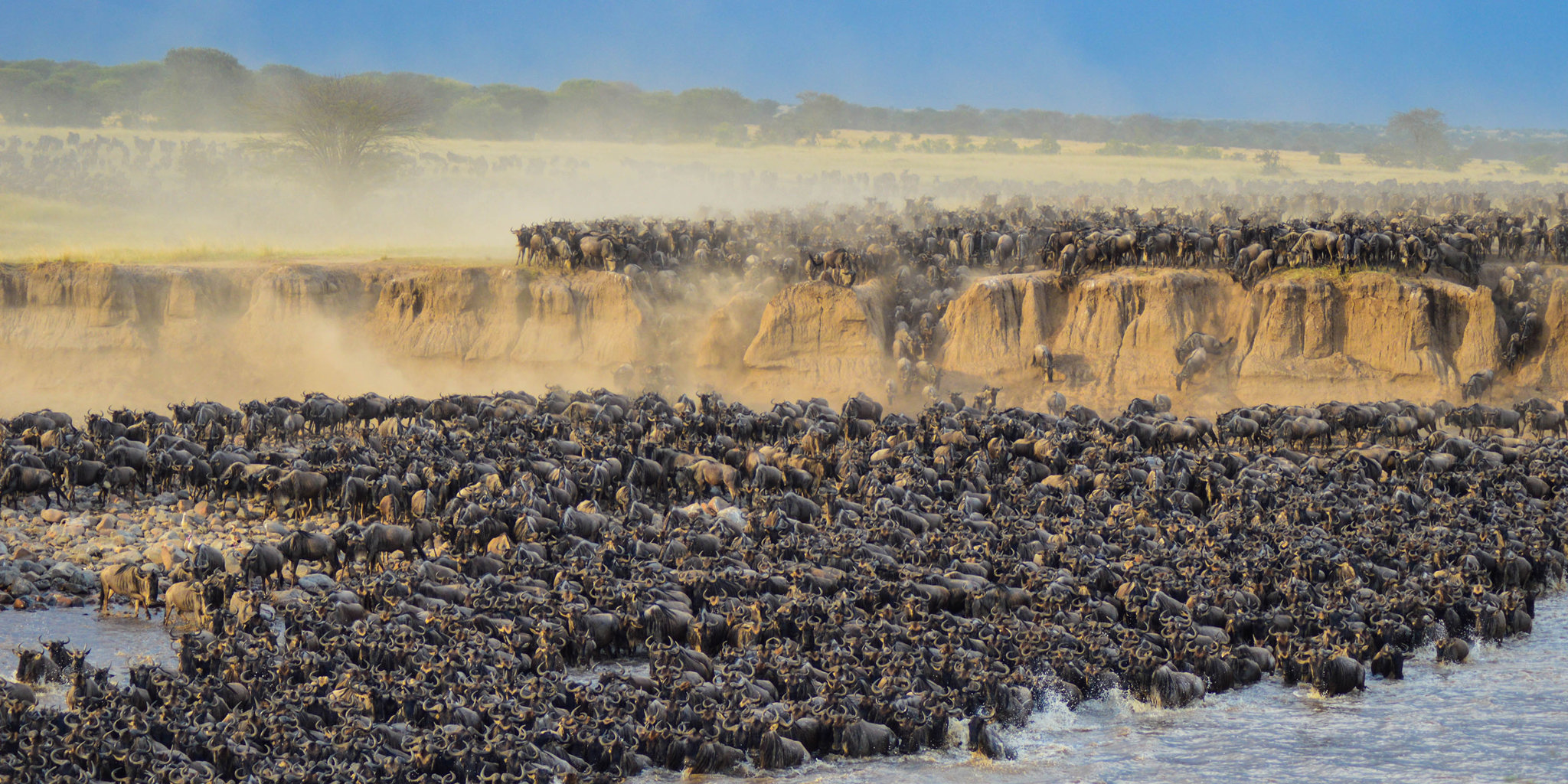An introduction to this 12 part blog series
In this blog series, one of our Co-founders Julian looks in detail at the Serengeti’s Great Migration. He talks specifically about each month’s movements of the herds and all the other wildlife caught up in the action. There’s advice on the best places to stay throughout the year and Julian gives his thoughts on the best trips and parks to combine with your Serengeti safari. Intrigued? Read on...and over to you Julian!
I’ve always believed the best way to understand the movement of the Great Migration is to split the herds into two parts – the migrations ‘mega’ herds and the ‘splinter’ herds. Whether you are lucky enough to view the mega herds on your trip is certainly down to good planning, but also unfortunately a rather large element of luck. The Great Migration is vast – approximately 1.5 million wildebeest, 300,000 zebra and 200,000 antelope – but it is also somewhat unpredictable. I have seen wildebeest go north and then go south over the Mara River all in the same day! The reality is we are dealing with a unique, fascinating species…that fools even the most experienced safari guides.
On this 12-part blog series I’ve given my best prediction for where the herds will be every month. This is based on data from satellite tagged wildebeest as well as the best part of twenty years studying the movement of the herds as a personal passion, and also for my clients trips.
The reality is their exact location can never be 100% guaranteed. There are times of year that predicting their location is much easier than others, but the reality is this ‘Great Migration’ is simply dependent upon unpredictable factors. Water and the best grazing are the main driving forces behind the movement of the herds; ultimately two factors that are at the mercy of local rainfall patterns across the whole Serengeti-Mara eco-system. Wildebeest are then also incredibly picky….and prefer grass at the perfect nutritious level!
I would summarise their movement by thinking about the Serengeti’s wet and dry seasons…and the transitional time in between those periods.
The wet season (from December through to May) sees the herds in the southern Serengeti and northern Ngorongoro Conservation Area. This is calving season.
The word ‘Serengeti’ is from the Maasai word ‘Siringit’, meaning ‘endless open plains’. The southern stretch is the part of the Serengeti that gave the park its famous name. Needless to say, the scenery here is really quite fantastic – huge open skies and boundless flat plains that sprawl as far as the eye can see! The plains are punctuated by occasional rock kopjes and small forests (such as those found around Lake Ndutu), where the majority of resident game can usually be found. However, the plains themselves are very seasonal, filled with the Great Migration from as early as mid-November through to as late as May. They remain void of game for the rest of the year, making the Southern Serengeti a seasonal part of the park.

The frontrunners of the wildebeest herds will hit this region from as early as mid-November, but it’s a safe bet to book a trip down here from mid-December onwards. From this point on, the entire Migration settles into the region and remains there for the next four months. Calving season itself usually occurs in February, when approximately half a million wildebeest are born in a matter of weeks. Viewing a birth is a real possibility – seeing a baby wildebeest able to run with the herd in a matter of minutes is a truly awesome sight! Cheetah sightings are also exceptional down here – the very best in Africa – whilst the general predator concentrations are the highest in Africa at any time of year.
May and June is a transitional period as the herds move north to their dry season grazing grounds of the Maasai Mara and northern Serengeti. It is a time that more than half of the Great Migration will move out to the western corridor on their migration north - another area of very rich grass and soil. It is also rutting season.
Finally comes the dry season (from July though to October) when the herds are located in the far north of the Serengeti and the Maasai Mara. This is river crossing season.

These months see the herds in the far north of the Serengeti, stretching from Kogatende and Bologonja to the Maasai Mara itself. The farther north you go in the Serengeti, the higher you climb in terms of altitude and the hillier the region becomes. Due to the fact that the entrance to the park is approximately 200km farther south, this is a region that gets few visitors compared with other areas. It is probably my favourite part of the Serengeti!
The eastern part of the North Serengeti, crossing towards the Kleins Hills and Northern Loliondo, is commonly known as Bologonja – a region most famous for the start of the northern plains as well as the Nyamalum Hills. Many people refer to it as Northern Lobo. With access possible from the central Serengeti, this is the part of the north that attracts the largest volume of visitor traffic but has great camps at great prices. They are in reach of the river crossing area. The north-west, however, is truly stunning and quieter than Bologonja. Famous due to the fact that the Mara River cuts down from Kenya’s Maasai Mara, this is the area of the Serengeti’s phenomenal Great Migration River Crossings!
The first herds will move up to the north at the end of June/beginning of July, with the mega herds usually hitting the region from 15th July onwards. They then spread out, splitting into hundreds of splinter herds that cross the Mara River daily in the search for fresh grasses. Their push south usually occurs from 15th October, but on a couple of occasions in recent years the last herds have been crossing the Mara River in mid-December! We recommend 15th July to the beginning of November as perfect timing.
The herds then enter a transitional period again (November and early December) as they move south to the wet season grazing grounds in the south of the park.
Just to the north of the Serengeti’s southern short grass plains, the central Seronera river valley begins. From November through to mid-December, the herds move through the region as they head to the Serengeti’s short grasses. It’s an amazing time of year to travel for value alone, as lodges drop their rates by 30 per cent (or over!), game viewing remains excellent, and the weather is still good! The only caveat for travelling during this period is that it is an unpredictable time of year to see the herds – so splitting your time between two areas is essential. Rain can also be an issue the later you travel in this period.
According to one argument, this central Serengeti region showcases the park at its very best (due to the sheer concentration of game), but also at its utter worst (due to how many hotels are in the area). However November to mid-December sees fewer tourists in the park than usual – it’s a clever time of year to visit, especially if you stay in the peripheral areas of Moru (south) or the Semetu region of the park, just south of Lerali Medungi. Some clients also stay in the properties to the north of Seronera – around the Togoro Plains.
A final summary
To truly understand the science behind their movement you would have to understand the make up of the entire eco-system, from varying levels of rainfall across the region, the different gradients and quality of soils and the different grasses that provide the nutrients and minerals a wildebeest needs (and will search out!). I will do my best to summarise this 'science' throughout these blogs... and use it to put you in the very best location for the herds.
However the Serengeti is to me the ‘mother’ of all safari parks - an extraordinary place that constantly surprises me. The Great Migration only adds to the glory of this exceptional park; it is without any doubt one of the greatest wildlife experiences on earth. Every day in the Serengeti, is different to the next!
January | February | March | April | May | June | July | August | September | October | November | December
 USA
USA
 UK / International
UK / International
 CA
CA
 Australia
Australia





